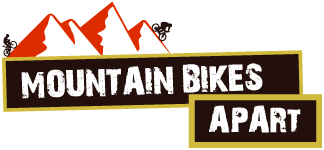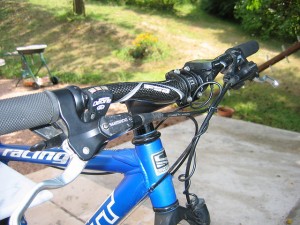Handlebars get a rough deal, I reckon. There are fancier parts, I’ll admit, but most people seem to just chuck on any old handlebar, and spend far less on it than on their gears or brakes, for example. But, considering its the bit of the bike that offers you most of the control, it’s defnitely worth going into a bit more detail on the different types of bars you can buy.
Handlebars affect many aspects of your ride. Obviously steering is a big factor, but they also affect your riding position and aerodynamics. It’s important that you have the right set of handlebars for maximum comfort and control. Let’s have a look at the varieties and what they’re best for.
Types of Mountain Bike Handlebars
There are a few types of mountain bike handlebars, but they can generally be categorised into two main groups: flat or riser.
Flat handlebars are the original type of bar for mountain bikes, they have a very simple and straight design that offers good strength and durability. Flat bars will mean your natural riding position moves slightly forwards with bent elbows. It is becoming more popular for flat bars to be made from carbon fibre, rather than aluminium, to reduce the weight even further, making them ideal for steep climbs or cross country.
Riser handlebars were once only used for extreme riding, but are now the preferred option for the majority of mountain bikers as they allow you to sit up straighter and have a much wider grip. Riser bars are straight in the middle but they rise slightly before straightening again for the brakes and grips.
Handlebar Width
As a general rule, bikers should opt for handlebars around 10cm wider than their shoulders, but some riders will prefer more leverage and others less.
Archimedes once said “Give me a lever long enough and a fulcrum on which to place it and I shall move the world”. The same logic can be applied to your handlebars, the wider they are, the more control they offer the rider. However, this control and responsiveness does come at a price, as wide bars will prevent you from making quick turns. Some riders will also find that wide bars cause their wrists arms to ache or become numb.
Therefore, the width of handlebars you want will depend on the type of mountain biking you do. Cross-country bikers and racers will prefer a narrower bar, usually around 55-60cm, whereas those biking downhill will want to go wider.
Some will argue that you should always opt for a wider bar because then you have the option of cutting it down with a hacksaw, but this isn’t ideal as you will likely void the warranty.
Choosing the Right Handlebar Clamp size
Mountain bike handlebars come in two different thicknesses in the centre to fit different stem clamp sizes: 25.4mm (traditional) or 31.8mm (oversized).
Oversized bars are slightly heavier than the traditional ones but they do increase the strength and stiffness. However, it’s not really recommended that you consider changing sizes unless you happen to be replacing the bar and stem at the same time anyway.
Material
Handlebars can be made from all sorts of different types of metal, the most common being aluminium. However, many high end bikes will sport carbon fibre bars, designed to be much lighter, and in some cases where strength is of utmost importance, steel us used.
There is not one material that is better than the other because how the bars have designed and manufactured plays a major part, as does personal preference.
Bar ends or Not?
It may take some convincing to make riders see the benefits that bar ends can have as they are probably one of the least fashionable bike accessories out there. However, despite being rather uncool, bar ends do provide an easy change of position and give a much more comfortable ride, so it’s best to try them out before completely dismissing them.
Be sure to check the warranty though as some bars aren’t strong enough to take them.
Brands
As with anything we buy these days, the brand of handlebars will often play a major part in our decision-making process. To give you a helping hand, we’ve narrowed down a list of great handlebar brands:
- Easton: a well-known and respected brand that has been operating since the 1984 Olympics in Los Angeles. Easton is often at the forefront of new technologies and offers great value for money on high quality bars.
- Ritchey: cycling equipment designed and manufactured by an avid rider. Tom Ritchley founded his company almost 40 years ago and is now one of the most popular brands in the world.
- Crank Bros: perhaps best known for their innovative clipless pedals, they also sell some of the best handlebars around. Everything created by the Crank Brothers is insanely attractive, but there is substance behind the style too.
- Truvativ: Leading bike component company SRAM is now behind the Truvativ brand, so you can be confident that their bars are of top quality. SRAM is a passionate and driven brand always trying to fine tune and perfect their products.



I have noticed you don’t monetize your page, don’t waste your traffic,
you can earn extra bucks every month. You can use the best adsense alternative for any
type of website (they approve all websites), for more details simply search in gooogle: boorfe’s tips monetize your website